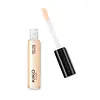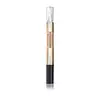What's inside
What's inside
 Key Ingredients
Key Ingredients

 Benefits
Benefits

 Concerns
Concerns

 Ingredients Side-by-side
Ingredients Side-by-side

Water
Skin ConditioningDimethicone
EmollientTalc
AbrasivePhenyl Trimethicone
Skin ConditioningCetyl PEG/PPG-10/1 Dimethicone
EmulsifyingIsododecane
EmollientGlycerin
HumectantHdi/Trimethylol Hexyllactone Crosspolymer
Phenoxyethanol
PreservativeAcrylates/Dimethicone Copolymer
Skin ConditioningSodium Chloride
MaskingHydrogen Dimethicone
Magnesium Sulfate
Dimethicone/Vinyl Dimethicone Crosspolymer
Skin ConditioningSodium Dehydroacetate
PreservativeAluminum Hydroxide
EmollientDisteardimonium Hectorite
StabilisingBenzoic Acid
MaskingTetrasodium EDTA
Dehydroacetic Acid
PreservativePropylene Carbonate
SolventSilica
AbrasiveEthylhexylglycerin
Skin ConditioningHelianthus Annuus Seed Oil
EmollientMethicone
EmollientVitex Agnus Castus Extract
AstringentCI 77891
Cosmetic ColorantCI 77492
Cosmetic ColorantCI 77007
Cosmetic ColorantCI 77288
Cosmetic ColorantWater, Dimethicone, Talc, Phenyl Trimethicone, Cetyl PEG/PPG-10/1 Dimethicone, Isododecane, Glycerin, Hdi/Trimethylol Hexyllactone Crosspolymer, Phenoxyethanol, Acrylates/Dimethicone Copolymer, Sodium Chloride, Hydrogen Dimethicone, Magnesium Sulfate, Dimethicone/Vinyl Dimethicone Crosspolymer, Sodium Dehydroacetate, Aluminum Hydroxide, Disteardimonium Hectorite, Benzoic Acid, Tetrasodium EDTA, Dehydroacetic Acid, Propylene Carbonate, Silica, Ethylhexylglycerin, Helianthus Annuus Seed Oil, Methicone, Vitex Agnus Castus Extract, CI 77891, CI 77492, CI 77007, CI 77288
Water
Skin ConditioningCyclopentasiloxane
EmollientTitanium Dioxide
Cosmetic ColorantPropylene Glycol
HumectantDimethicone
EmollientTalc
AbrasiveAluminum Starch Octenylsuccinate
AbsorbentPEG/PPG-18/18 Dimethicone
EmulsifyingSodium Chloride
MaskingPvp
Emulsion StabilisingLaureth-7
EmulsifyingTrihydroxystearin
Skin ConditioningMethicone
EmollientHydrogenated Soybean Oil
EmollientParaffin
PerfumingPolyglyceryl-4 Isostearate
EmulsifyingCetyl PEG/PPG-10/1 Dimethicone
EmulsifyingHexyl Laurate
EmollientSilica
AbrasiveStearic Acid
CleansingEthylene/Methacrylate Copolymer
Synthetic Wax
AbrasiveCera Microcristallina
Emulsion StabilisingPolyethylene
AbrasiveAluminum Hydroxide
EmollientSodium Dehydroacetate
PreservativePropylparaben
PreservativeMethylparaben
PreservativeEthylene Brassylate
MaskingCI 77492
Cosmetic ColorantCI 77491
Cosmetic ColorantCI 77499
Cosmetic ColorantWater, Cyclopentasiloxane, Titanium Dioxide, Propylene Glycol, Dimethicone, Talc, Aluminum Starch Octenylsuccinate, PEG/PPG-18/18 Dimethicone, Sodium Chloride, Pvp, Laureth-7, Trihydroxystearin, Methicone, Hydrogenated Soybean Oil, Paraffin, Polyglyceryl-4 Isostearate, Cetyl PEG/PPG-10/1 Dimethicone, Hexyl Laurate, Silica, Stearic Acid, Ethylene/Methacrylate Copolymer, Synthetic Wax, Cera Microcristallina, Polyethylene, Aluminum Hydroxide, Sodium Dehydroacetate, Propylparaben, Methylparaben, Ethylene Brassylate, CI 77492, CI 77491, CI 77499
Ingredients Explained
These ingredients are found in both products.
Ingredients higher up in an ingredient list are typically present in a larger amount.
Aluminum Hydroxide is a form of aluminum. It can be naturally found in nature as the mineral gibbsite. In cosmetics, Aluminum Hydroxide is used as a colorant, pH adjuster, and absorbent.
As a colorant, Aluminum Hydroxide may add opacity, or reduce the transparency. Aluminum hydroxide is contains both basic and acidic properties.
According to manufacturers, this ingredient is an emollient and humectant. This means it helps hydrate the skin.
In medicine, this ingredient is used to help relieve heartburn and help heal ulcers.
There is currently no credible scientific evidence linking aluminum hydroxide in cosmetics to increased cancer risk.
Major health organizations allow the use of aluminum hydroxide in personal care products and have not flagged it as a carcinogenic risk at typical usage levels.
Learn more about Aluminum HydroxideThis ingredient is a high molecular weight silicone. It has emulsifying and skin conditioning properties.
Ci 77492 is also hydrated iron III oxide. It's sole purpose is to give a yellow hue to products.
Iron III oxides are classified as inorganic chemicals for coloring.
Synthetically created Ci 77492 is considered safer than those naturally found. This is because the synthetically created version may contain less impurities. Iron oxides are generally non-toxic and non-allergenic.
Learn more about CI 77492Dimethicone is a type of synthetic silicone created from natural materials such as quartz.
What it does:
Dimethicone comes in different viscosities:
Depending on the viscosity, dimethicone has different properties.
Ingredients lists don't always show which type is used, so we recommend reaching out to the brand if you have questions about the viscosity.
This ingredient is unlikely to cause irritation because it does not get absorbed into skin. However, people with silicone allergies should be careful about using this ingredient.
Note: Dimethicone may contribute to pilling. This is because it is not oil or water soluble, so pilling may occur when layered with products. When mixed with heavy oils in a formula, the outcome is also quite greasy.
Learn more about DimethiconeMethicone is a type of silicone and is a simpler form of dimethicone.
Silicones are used to enhance the texture of products and have emollient properties. Methicone is used to give products a silky texture and improves spreadability.
Silica, also known as silicon dioxide, is a naturally occurring mineral. It is used as a fine, spherical, and porous powder in cosmetics.
Though it has exfoliant properties, the function of silica varies depending on the product.
The unique structure of silica enhances the spreadability and adds smoothness, making it a great texture enhancer.
It is also used as an active carrier, emulsifier, and mattifier due to its ability to absorb excess oil.
In some products, tiny microneedles called spicules are made from silica or hydrolyzed sponge. When you rub them in, they lightly polish away dead skin layers and enhance the penetration of active ingredients.
Learn more about SilicaChances are, you eat sodium chloride every day. Sodium Chloride is also known as table salt.
This ingredient has many purposes in skincare: thickener, emulsifier, and exfoliator.
You'll most likely find this ingredient in cleansers where it is used to create a gel-like texture. As an emulsifier, it also prevents ingredients from separating.
There is much debate on whether this ingredient is comedogenic. The short answer - comedogenic ratings don't tell the whole story. Learn more about comegodenic ratings here.
The concensus about this ingredient causing acne seems to be divided. Research is needed to understand if this ingredient does cause acne.
Scrubs may use salt as the primary exfoliating ingredient.
Learn more about Sodium ChlorideThis ingredient is a preservative with antimicrobial properties. It is the sodium salt of dehydroacetic acid.
It is especially effective at preventing bacterial and fungal growth in low concentrations.
Talc is a clay mineral. It helps absorb moisture and improve the texture of products. Like other types of clay, Talc can have a slight exfoliating effect on skin. Talc can be added to increase the volume of products.
Some Baby powders are made by combining talc with corn starch. The word "talc" comes from Latin and originates from Arabic. Talc is a mineral commonly found throughout the world.
If you have any concerns about using talc, we recommend checking out the FDA's official page.
Learn more about TalcWater. It's the most common cosmetic ingredient of all. You'll usually see it at the top of ingredient lists, meaning that it makes up the largest part of the product.
So why is it so popular? Water most often acts as a solvent - this means that it helps dissolve other ingredients into the formulation.
You'll also recognize water as that liquid we all need to stay alive. If you see this, drink a glass of water. Stay hydrated!
Learn more about Water